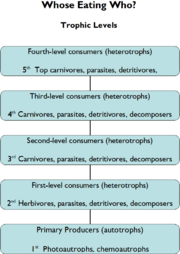Who's Eating Who?
| Instant wiki maker | Making handouts | Editing tips |
Contents
- 1 Whose Eating Who?
- 1.1 Student worthiness
- 1.2 Primary biological content area covered
- 1.3 Materials
- 1.4 Handouts
- 1.5 Description of activity
- 1.6 Lesson plan
- 1.7 Potential pitfalls
- 1.8 Art connections
- 1.9 Literature connections
- 1.10 Connections to educational standards
- 1.11 Next steps
- 1.12 Citations and links
- 1.13 Reflections
Biology In Elementary Schools is a Saint Michael's College student project from a course that ran between 2007 and 2010 and fully described in this book chapter. The student-created resources have been preserved here for posterity. Link under 'toolbox' for printer-friendly versions of the exercises. Click on handouts to print full resolution versions. Please see Wikieducator's disclaimer, our safety statement, and the Creative Commons licensing in English and in legalese.
Whose Eating Who?
Student worthiness
Tested
Primary biological content area covered
Trophic levels of a food chain
Materials
Materials required for the teacher's use:
- Handout with trophic levels and picture examples
- Example food chain
Materials that each individual student would need
- Magazines with animals (ex. National Geographic, Ranger Rick, Big Backyard)
- Scissors
- Glue sticks
- Construction paper
Handouts
See Below.
Description of activity
First the teacher will explain the 5 trophic levels of a food chain to the students using the hand out with the sample food chain (Figure 1). Then once they have learned about trophic levels, autotrophs, and heterotrophs, each student can begin looking through the magazines and cutting out pictures of animals to create their own food chain. Once each student has completed his or her food chain, you can have them share them with the group.
Lesson plan
- Hand out the reference page of the trophic levels (figure 1) to each student.
- First explain the difference between an autotroph and a hetertroph.
- Verify that they know the differences between carnivores, omnivores, and herbivores.
- Next go through each level making sure that each student understands the characteristics of each.
- Provide magazines and scissors for each student to cut out organisms for his or her food chain.
- Once they have finished cutting pass out the glue sticks and construction paper and have each student glue his or her food chain to the construction paper.
- Next have them label each level of their food chain.
- Ask students to share their food chains in small groups.
Potential pitfalls
Some problems that you may encounter may be difficulty with vocabulary and confusion distinguishing between the different trophic levels.
Art connections
Students will be drawing pictures of some of the animals enhancing their visual arts experience.
Literature connections
Babies in the Bayou by Jim Arnosky
Connections to educational standards
Visual Arts – 5.29 Students use the elements and principles of two and three dimensional design in the visual arts, including line, color, shape, and texture, in creating, viewing, and critiquing.
Organisms, Evolution, and Interdependence – 7.13 Students understand the characteristics of organisms, see patterns of similarity and differences among living organisms, understand the role of evolution, and recognize the interdependence of all systems that support life.
Next steps
Once you have covered a simple food chain or web you may continue the lesson by talking about different relationship between animals other than predator and prey situations. For instance relationships that benefit both organisms could be explored.
Citations and links
http://www.instructorweb.com/lesson/animals.asp This website would be very helpful when looking for handouts or a follow up activity.
Reflections
This lesson was very interesting for us to do because it produced many questions by the students that also challenged us. One of the questions that was asked numerous times was whether or not elephants eat other animals like a monkey or something along those lines. The challenge was not in the answer here but rather once we told them that they did not and that they only eat leaves and smaller things, they wanted to know how elephants got so big if all they ate were plants. This was a challenge for us to explain to them. It was also interesting to see how some students took the initiative to make their food webs very complex while others barely finished the bear minimum. We were a little pressed for time though I feel like a half an hour would have been sufficient but only twenty minutes was a little more difficult.
We have recently received feedback from the classroom teacher that we work with on the lesson and she has told us that having the list of vocabulary was crucial to the project itself. She said that many times, students just need the confidence of having the words next to the to look at whenever they need to rather than constantly having to ask how to spell something. Many students may not be confident in themselves or are too shy to ask in the first place.

